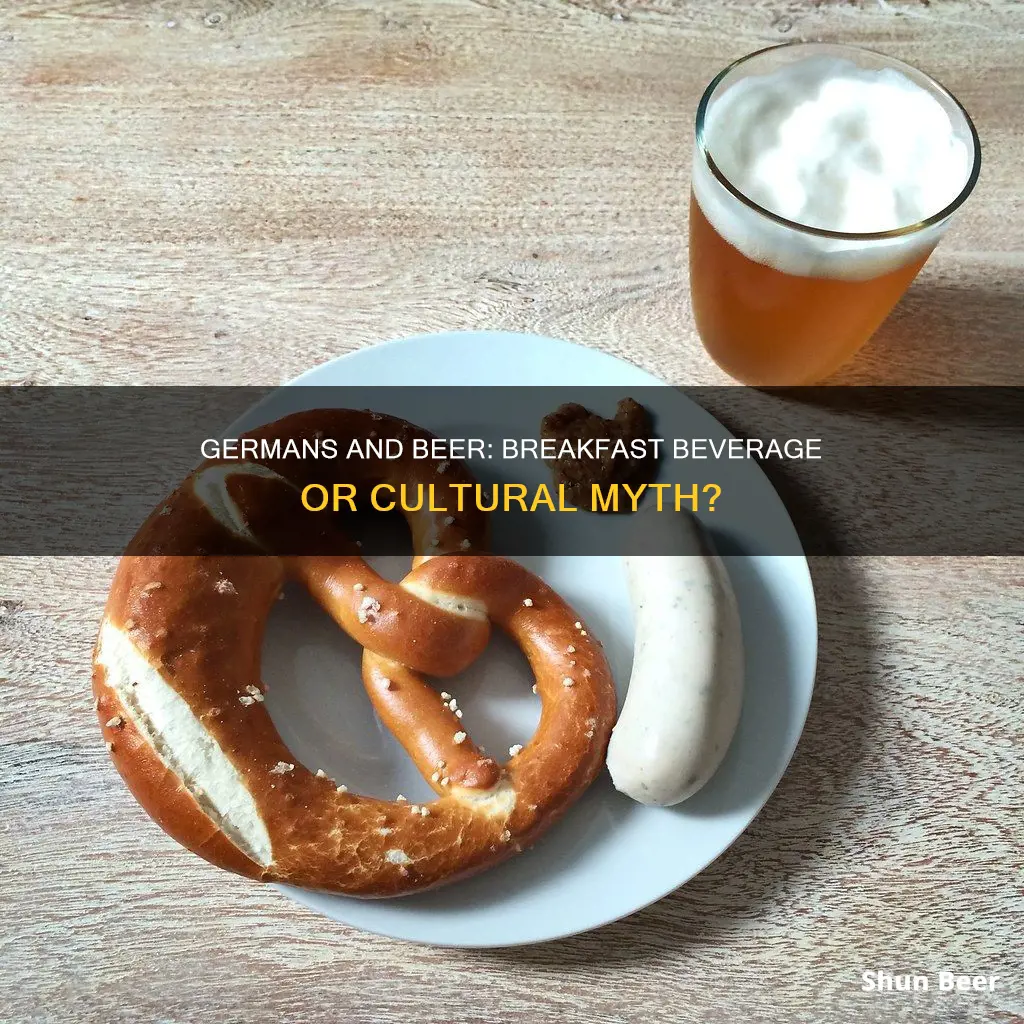
In Germany, it is common to drink beer before noon, especially in the German federal state of Bavaria. The tradition is called Frühschoppen and involves drinking a specific type of beer called hefeweizen, which is made from malted wheat and has a cloudy appearance due to its unfiltered nature. Bavarians may drink hefeweizen at any time of day, but it is typically consumed during a second breakfast called brotzeit, which usually takes place around 11 am. This breakfast often includes bread, butter, cheese, pickles, veal sausage, mustard, and, of course, hefeweizen. The German word for this type of beer, hefeweizen, translates to yeast wheat, reflecting its unique fermentation process.
What You'll Learn
- Hefeweizen is the beer of choice for breakfast in Germany
- Frühschoppen is the German tradition of drinking before noon
- Bavarians may drink beer at any time, but it is most common during the second breakfast, or brotzeit
- Wheat beer, or Weißbier, is a beer brewed with a large proportion of wheat
- German beer culture is so prevalent that it is hard to escape from beer in social situations

Hefeweizen is the beer of choice for breakfast in Germany
In Germany, it is common to drink beer before noon, and the beer of choice for breakfast is Hefeweizen. This is especially true in the German federal state of Bavaria, where a "second breakfast" is common. Bavarians even have a linguistic term, Frühschoppen, which means an alcoholic drink before midday.
Hefeweizen is a beer made from malted wheat, rather than the typical malted barley that is familiar to most beer drinkers. It is brewed with at least 50% wheat malt, and the aroma and flavour come largely from the yeast. This gives Hefeweizen its distinctive cloudy appearance, as the yeast remains in suspension. The beer has a low to moderate alcohol content, typically ranging from 4.9% to 5.6% ABV.
Hefeweizen is light, spritzy, and fragrant with yeasty aromas, making it a wonderful option for a breakfast beer. It pairs well with a variety of breakfast foods, including eggs, seafood, and salads, and even sweeter dishes like apple strudel. The banana and clove flavours of Hefeweizen also complement traditional Bavarian breakfast foods such as pretzels, white sausage, and veal sausage.
The unfiltered nature of Hefeweizen gives it a cloudy appearance, and it is typically served in a tall, curvaceous glass called a Weizen vase. This type of glass showcases the beer's beautiful glow and corrals its large, persistent foam head. While it may seem unusual to drink beer with breakfast, in Bavaria, it is simply part of their culture and diet.
Mixing Vyvanse and Beer: Is It Safe?
You may want to see also

Frühschoppen is the German tradition of drinking before noon
Hefeweizen is a type of beer made from malted wheat rather than malted barley. It also contains specialised strains of yeast that produce overtones of clove, banana, apples, citrus, and smoke during the fermentation process. The name "hefeweizen" translates to "yeast wheat", and the beer is left unfiltered, giving it a cloudy appearance.
The tradition of Frühschoppen is deeply ingrained in Bavarian culture, and drinking an alcoholic beverage before midday is common. This tradition is not limited to special occasions but is instead a regular part of daily life. Bavarians approach beer differently than Americans, who typically associate it with foggy-headedness and laziness. In Bavaria, beer is considered part of a healthy diet, and hefeweizen is even referred to as "bottled bread".
The German Chancellor Angela Merkel welcomed then-US President Barack Obama with a full Bavarian breakfast, including hefeweizen, during the 41st G7 summit in 2015. However, to remain sober for the summit, Obama drank non-alcoholic hefeweizen.
Beer and Fluconazole: Is It Safe to Drink?
You may want to see also

Bavarians may drink beer at any time, but it is most common during the second breakfast, or brotzeit
In Bavaria, a German federal state in the southeast of the country, it is common to drink beer before noon. Bavarians may drink beer at any time, but it is most common during the second breakfast, or "brotzeit". This typically takes place in the late morning, around 11 am. During brotzeit, Bavarians will often sit down to a simple meal of bread, butter, cheese, pickles, veal sausage, mustard, and a tall vase of hefeweizen beer.
Hefeweizen is made from malted wheat and uses specialised strains of yeast, which produce overtones of clove, banana, apples, citrus, and smoke during the fermentation process. The name hefeweizen translates to "yeast wheat", and the beer is left unfiltered, giving it a cloudy appearance. Bavarians refer to hefeweizen as "bottled bread", and it is considered a staple of their diet.
The tradition of drinking beer before noon is not limited to Bavaria. During the annual Karneval celebration in Cologne, for example, people of all ages and backgrounds traditionally start drinking at 11 am and continue until the following Tuesday. Kölsch, the local brew, is considered a cornerstone of Rhineland culture.
While the tradition of drinking beer for breakfast may seem unusual to some, it is deeply ingrained in German culture. In fact, when US President Barack Obama visited Bavaria for the G7 summit in 2015, he was welcomed with a traditional Bavarian breakfast, including a glass of non-alcoholic hefeweizen.
Beer and the Bible: Drinking Guidelines
You may want to see also

Wheat beer, or Weißbier, is a beer brewed with a large proportion of wheat
In the German federal state of Bavaria, it is common to drink beer before noon. This is usually done during a "second breakfast", called "brotzeit", which takes place around 11 am. Bavarians have a specific beer for this time of day called "hefeweizen", which is made from malted wheat instead of malted barley. Hefeweizen is also unfiltered, giving it a cloudy appearance.
Hefeweizen is a type of wheat beer, or "Weißbier" in German. Wheat beer is typically a top-fermented ale, using at least 30% wheat in the brewing process, though German wheat beer uses at least 52% wheat. It comes in a variety of styles, with the most widely known being hefeweizen. Wheat beers are usually light in colour, low to medium in alcohol content (around 5%), and can be cloudy or clear in appearance. They may be brewed with or without hops, and tend to lack bitterness.
The two main varieties of wheat beer are German Weizenbier and Belgian witbier. Other types include Lambic (made with wild yeast), Berliner Weisse (a cloudy, sour beer), and Gose (a sour, salty beer). Wheat beer is known by a few different names, especially in Germany and the surrounding region where it originated. These include Weißbier (Bavaria and Austria), Weizenbier or Weizen (Northern and Western German regions), and Bière Blanche (France).
The special strains of yeast used in the fermentation process of hefeweizen produce overtones of clove, banana, apples, citrus, and even smoke. The term "Hefeweizen" or "Hefeweißbier" refers to wheat beer in its traditional, unfiltered form. The unfiltered nature of hefeweizen gives it a cloudy aesthetic that lies somewhere between translucent and opaque.
In Bavaria, wheat beer is typically served in a tall, thin glass. It is considered to be a food, rather than an agent for producing fogginess and laziness, as it is sometimes viewed in America.
Beer Drinking and Weight Loss: Is It Possible?
You may want to see also

German beer culture is so prevalent that it is hard to escape from beer in social situations
The traditional Bavarian breakfast includes pretzels, white sausage (Weißwurst), and wheat beer (Weißbier). The wheat beer, also known as hefeweizen, is a unique type of beer made from malted wheat and specialised yeast strains, resulting in a cloudy, unfiltered beverage with notes of clove, banana, apples, citrus, and smoke. Bavarians may drink hefeweizen at any time of day, but it is typically enjoyed during the "second breakfast", known as brotzeit, which usually takes place around 11 am.
The German approach to beer is different from that of other cultures, especially the United States. In Bavaria, beer is considered a basic foodstuff, sometimes referred to as "bottled bread". It is viewed as a staple of their diet rather than solely as an alcoholic beverage. This is evident in the way beer is consumed casually at any time of day, including in the morning, and is readily available in various social settings.
The prevalence of beer in German culture can be observed in everyday life, whether it's at a restaurant, bar, or even at home. It is not uncommon for Germans to drink beer during breakfast, and this tradition is deeply rooted in their cultural identity. This love for beer is not just limited to Bavaria but can be seen throughout Germany, where drinking beer at all hours of the day is normalised.
While German beer culture may be surprising to outsiders, it is an integral part of the country's social fabric. The German attitude towards beer reflects a different perspective on alcohol, where beer is not necessarily associated with intoxication but is instead woven into their daily lives as a culinary tradition. This prevalent beer culture showcases the deep connection Germans have with this beloved beverage.
Beer and Klonopin: Safe Mix or Risky Business?
You may want to see also
Frequently asked questions
Yes, it is common for Germans, especially in the Bavarian state, to drink beer at breakfast. In fact, they have a specific beer for this time of day called hefeweizen, which is made from malted wheat and has a cloudy aesthetic.
Bavarians don't need to justify drinking beer at breakfast because it's simply part of their culture. However, if they had to give a reason, they would likely say that hefeweizen aids digestion.
A traditional Bavarian breakfast typically includes pretzels, white sausage (Weißwurst), and wheat beer (Weißbier).
While drinking beer in the morning may be a long-standing tradition in Germany, it is important to consider the health risks associated with alcohol consumption. According to medical advice, there is a strong link between alcohol abuse and certain types of cancer. Therefore, drinking in the morning is probably not a good idea.







